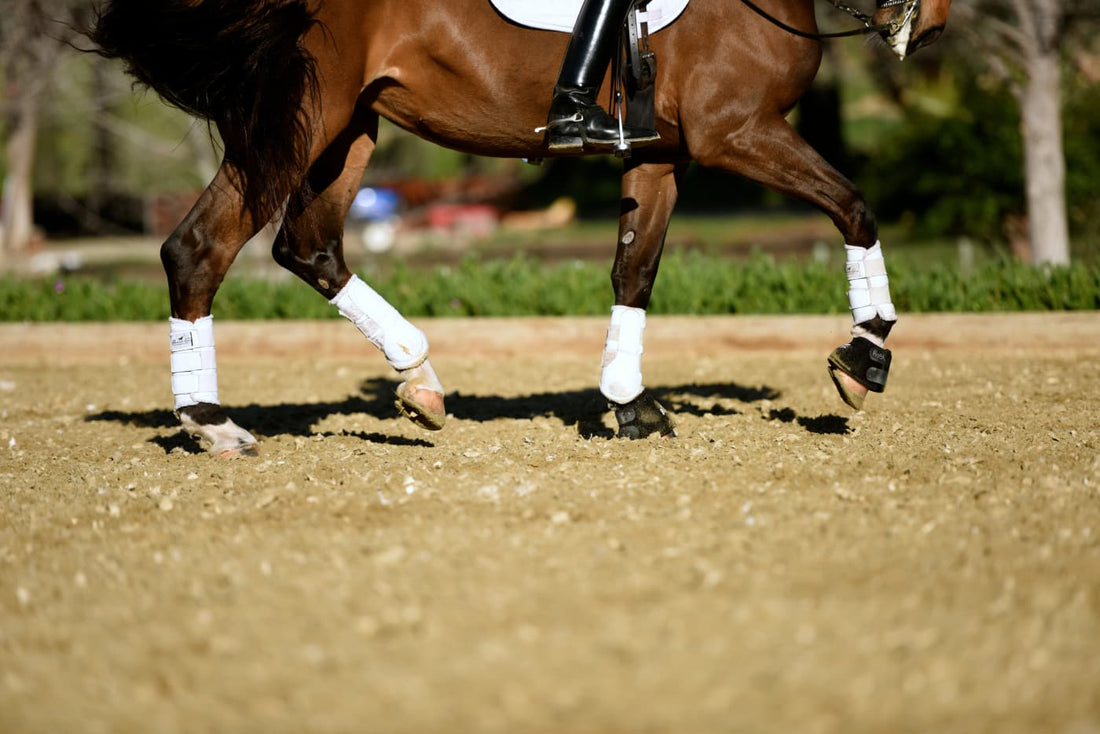What sort of footing do you ride on every day? Who has the best footing at shows? Do you often think: I can’t ride there—the footing is too hard and dusty. The footing in dressage arenas both at home and at shows is one of the most important components in any dressage rider’s life. You want to ride your horse on a surface that is good enough to keep him sound throughout daily training.

What we know is that arena footing has become a science, but not an exact one. Research is being done to find out how horses (in all disciplines) can avoid injury, and footing/surface providers are working to find the best solutions for individual arenas in the United States and around the world. Here are a few stories from the trenches about what goes on in the world of footing for dressage horses.
Footing Research
Susan Stover, BS, DVM, PhD, is a professor of anatomy, physiology and cell biology at the University of California, Davis. She and her colleagues are part of the developing field of footing science. “There are definitely groups focused on footing-science research,” Stover explains. Her research team in the Veterinary Orthopedic Research Laboratory at Davis, is funded by the Grayson-Jockey Club Research Foundation, the Center for Equine Health (UC Davis) and the Veterinary Orthopedic Society.
Stover says that “The key and our long-term goal is to identify the characteristics of the ‘ideal’ surface for different sports so that surfaces can be designed and managed as is appropriate for whatever climate to have a consistent mechanical behavior for the horse.” She explains that the arena surface is of first importance in preventing injury. “So far, the biggest factor we know that affects surface behavior is the amount of cushion in the surface, which can be more important than the materials the surface is made of. So taking time to manage the surface is important.
“Secondly, we know it takes less work to maintain a fit horse than to get him fit in the first place. So be careful not to overtrain fit horses, particularly older campaigners who largely know how to perform their given tasks.” She adds that it is the repetitiveness of the same activity that can take a toll on horses’ musculoskeletal health. “The suspensory apparatus of the fetlock is the most commonly injured structure in dressage horses. Musculoskeletal structures need time to recover from very intense or long periods of repetitive bouts of exercise.
“The ideal surface can prevent over-extension of the fetlock by maintaining surface cushion. This means the surface must be firm enough to support the horse while providing cushion with a low enough stiffness to dampen the load. It must be responsive to return energy to the horse in an effortless manner, provide enough grip to allow some slide and prevent jarring with hoof contact but support the hoof during propulsion. It must also be uniform to provide a consistent experience with each stride.”
When it comes to the recipe for good footing in dressage arenas, Stover says this depends on the climate, use of the arena and other factors. “For instance, an outdoor arena in a hot, dry climate needs different surface materials than an outdoor arena in a wet, cold climate. However, both surfaces would be ideally designed and managed to provide the same mechanical behavior—support with cushion and some elasticity to return energy to the limb.”
Stover’s footing-science team is working toward their goal to guide arena design and management to optimize surfaces for injury prevention.
Arena Surfaces
There are many factors that contribute to a great arena surface—construction, water, grooming and maintenance, the riding discipline, et cetera—but the biggest one is the sand that will be used. The sand will determine the quality and consistency of the arena surface. The footing additives [textiles and rubber] are necessary to buffer, enhance and support the natural qualities of the sand. No amount of footing additives will improve unsuitable sand.
Finding suitable sand is a footing expert’s biggest dilemma. The challenge is not indoor or outdoor but rather where the arena is located and what the geology is in that region. But buyer beware: A sand quarry will call something ‘arena sand’ because a guy down the street put it in his arena. Most of them have no idea what dressage is, let alone the mechanics that are needed from sand. There are more than 10,000 different sand names in the U.S. alone.
The reason Aiken, South Carolina, and Ocala, Florida, became destination horse-sport areas is because those regions possessed very nice sands. The old-timers knew that a quality surface was important years ago.
People think buying a clean, washed sand is what they need. But this is probably the worst sand they could purchase for a dressage arena. If the sand is washed and not graded well, it will feel like you’re riding at the top of the beach in the dry, deep sand. If I could stress anything to help horse owners, it would be: Do not buy sand before speaking with a footing expert. This will save thousands of dollars and lots of frustration.
Another challenge for a footing provider is an arena in a drought region where people do not have the ability to water an arena. Water creates a molecular bond between sand particles it is a key factor in maintaining a high-performance arena. Waterless footings that contain oil, wax or polymers will change consistency with temperature. The grip and traction can vary greatly and affect the horse’s biomechanics, whereas water has exactly the same consistency from 33 to 165 degrees Fahrenheit.
Sometimes it is just better to start over and replace the sand in an arena. Stone dust or man-made sands can be amended with rubber products to keep them from compacting and getting hard.
Identifying Problems
Cynthia Brewster-Keating, national account manager for GGT-Footing, the equestrian division of Polysols Inc., has seen many challenges with footing materials in recent years. One of the most challenging was at a large outdoor show arena in the Midwest. “The facility was new and was running a big horse show when, during the first week of competition, it became clear that the arena footing material was not binding up properly,” Brewster-Keating recalls. “Binding up is when the sand and textiles cling to one another and form a ball that stays pretty much together. For example, if you grab a handful of footing and make it into a round, meatball-shaped ball then drop it, you want it to give way on landing but still mostly stay together. If that happens, you have a nice binding and a properly wet arena.”
This sounds good for a big show venue, but how do riders who board their horses, for example, decide if the footing is OK? Brewster-Keating gives these tips: “Footing that is too slippery, hard or deep can be dangerous. You must protect your horse’s tendons and ligaments from the strain in too deep sand that gives way.
“A rider should be able to stub her toe into the footing and see if it feels like concrete, is too deep or if the sand has a slight give, which is what you want. As far as too slippery, that would be a combination of things. If it is too hard, a horse’s hoof has no support around corners and the hind end can fall out around turns. Footing can be slippery if it is sloppy, wet or mushy, even if the horse is wearing caulks on his shoes.
“For a boarder, I suggest going to the facility right after a big rainstorm to see how the arena drains. Does it have a lake in it or a series of puddles? If so, then you know the footing is not draining well, so the base and the subsequent top layers are out of grade. You should expect an arena with good footing to be dragged daily, depending on environmental conditions, such as if the arena is in full sun or full shade or on top of a windy hill. Most professional horsemen water and drag their arenas every day. I have a dressage-sized ring and I water it three hours a day. The end result should feel as if you were walking along the edge of a beach. The arena footing should be wet [probably more than most people think] but not mushy. It should show a nice imprint of the horse’s hoof.”
When an arena becomes dusty, it probably means the sand has broken down and no longer supports the horses’ weight properly. It is time to replace it, says Brewster-Keating. “When an arena no longer drains properly or looks uneven especially to the human eye, you know it’s time to redo by grading or installing new drainage layers. All options should be discussed with an experienced arena builder. Technology has changed and the materials used today are much better for the horses and the environment. You’ll need an appropriate drag and enough water. These are the best ways to protect your arena for years of use. We have arenas in Europe that are 23 years old. With proper silica sand that is sub-angular and proper textiles and care, your arena will last for many years. Unfortunately, the biggest enemy is manure and other organic materials such as leaves or grass.”
Addressing Challenges
Having surfaced arenas all over the world, Nick Attwood, CEO of Attwood Equestrian Surfaces, realizes that all arenas come with challenges, mainly climate and availability of local materials. “Seattle comes with plenty of rain while Scottsdale comes with plenty of sun,” says Attwood. “The East Coast is blessed with many options for great sand, whereas the West Coast not so much. When working within a budget, our job is to explain the trade-offs and try to design the arena and formulate the footing to maximize the riding experience while minimizing the amount of maintenance.”
Attwood recalls a footing dilemma he recently experienced on the East Coast. “We completed three large competition arenas at Morven Park in Leesburg, Virginia. The main difficulties were optimizing the drainage versus the ability to keep three huge arenas watered during shows,” he explained. “Formulating the footing to keep the jumpers and dressage riders equally happy and trying to locate 10,000 tons of high-quality, suitable sand takes years of knowledge and experience. You would think most quarries would be ecstatic to receive such a large order, but even for large facilities, 10,000 tons puts a strain on their ability to supply their regular customers.”
Other challenges Attwood has faced include an arena in Hawaii where he had to bring sand in from China to achieve the optimum footing properties and another steep-hillside ring in Brentwood, California. “Sometimes, arenas are in tightly confined spaces,” recalled Attwood. “We installed an arena above the stables on a relatively steep hillside. A neighboring resident located above the arena on the hillside insisted the arena should be dust-free so they could enjoy their pool without dust from the arena drifting in. We did that, and after the arena was completed, the construction road that led up to the arena was removed and replaced with a narrower horse trail. When we returned many years later to carry out some arena maintenance, we had to get a huge crane to lift the necessary equipment, including a tractor, into the arena.”
The world of arena footing can be more complicated than one might think. But with proper research and a dedicated team of experts behind a project, the outcome will lead to more time riding and training.
BLOG SOURCE https://dressagetoday.com/lifestyle/find-your-dressage-arena-footing

